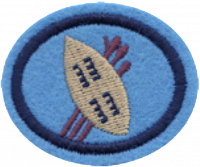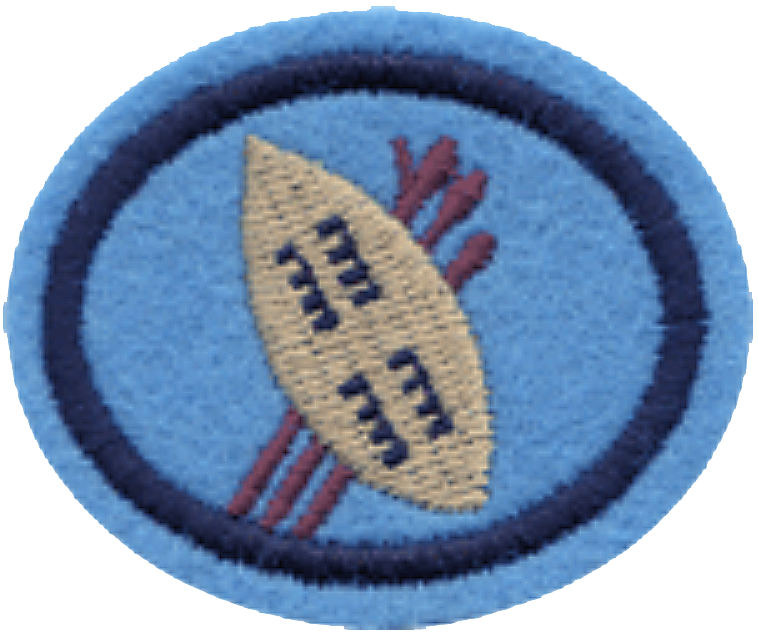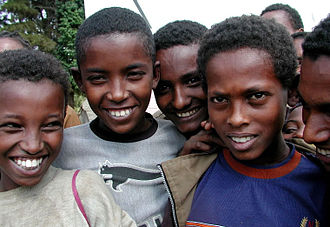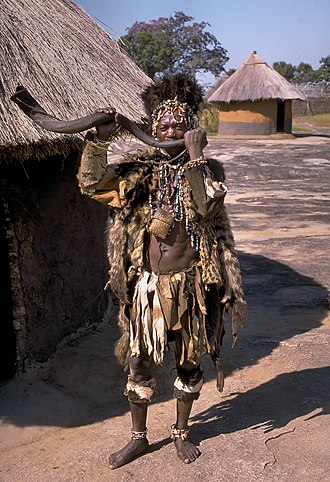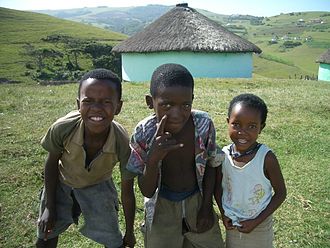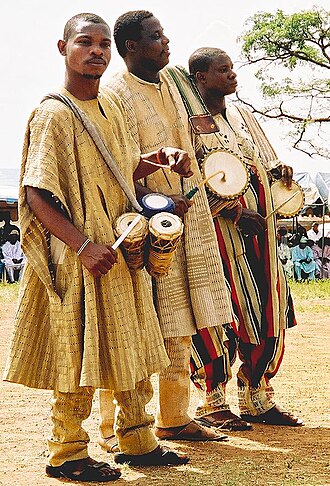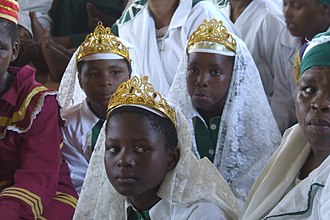Respuestas para la especialidad JA de Tradición africana usados por la División Norteamericana
Nivel de destreza
1
Año
2001
Version
07.12.2025
Autoridad de aprobación
División Norteamericana
1
Las respuestas para el requisito dos incluyen información acerca de la ubicación de las tribus descritas. Le sugerimos que consulte un mapa de África y, utilizando la información que se presenta a continuación, ubique las áreas donde se encuentran hoy las diez tribus. El requisito dos también proporciona muchas características sobresalientes de las tribus descritas.
2
2a
Hay miles de tribus en África y no pretendemos describirlas todas. Más bien, presentaremos una pequeña cantidad de las tribus más grandes aquí, u aun así, no con mucho detalle. Si una tribu africana que no se describe aquí le interesa, le recomendamos que la investigue. Si lo desea, puede agregar su investigación a esta página web.
2b
- i. Los hábitos alimenticios
- ii. Ceremonia de iniciación
- iii. Prácticas curativas
- iv. Condiciones de vida y cultos
- v. Educación
- vi. Entierros
- vii. Dinero
- iix. Vestimenta
- ix. Industria
|Initiation ceremony = Boys and girls are initiated into adulthood in a ceremony in which they are given their first clothes, called Ima Akwa. Until that time they are basically naked (and are considered to have nothing to hide until then), with the exception of beads worn for spiritual purposes.
|Shamans = The central human figure in the Maasai religious system is the laibon who may be involved in: shamanistic healing, divination and prophecy, insuring success in war or adequate rainfall. Whatever power an individual laibon had was a function of personality rather than position.
|Living conditions = As a historically nomadic and then semi-nomadic people, the Maasai have traditionally relied on local, readily available materials and indigenous technology to construct their housing. The traditional Maasai house was in the first instance designed for people on the move and was thus very impermanent in nature. The Inkajijik (houses) are either star-shaped or circular, and are constructed by able-bodied women. The structural framework is formed of timber poles fixed directly into the ground and interwoven with a lattice of smaller branches, which is then plastered with a mix of mud, sticks, grass, cow dung and human urine, and ash. The enkaji is small, measuring about 3m x 5m and standing only 1.5m high. Within this space the family cooks, eats, sleeps, socializes and stores food, fuel and other household possessions. Small livestock are also often accommodated within the enkaji. Villages are enclosed in a circular fence (Enkang) built by the men, usually of thorned acacia, a native tree. At night all cows, goats and sheep are placed in an enclosure in the center, safe from wild animals.
|Religion = The Maasai are monotheistic, and they call God Enkai or Engai. Engai is a single deity with a dual nature: Engai Narok (Black God) is benevolent, and Engai Nanyokie (Red God) is vengeful. The "Mountain of God", Ol Doinyo Lengai, is located in northernmost Tanzania. Many Maasai have become Christian, and to a lesser extent, Muslim.
|Education=During the British rule of East Africa, the Maasai engaged in a form passive resistance to preserve their culture. They refused to settle down, take up agriculture, or send their children to be educated by the British. Education was seen as a way to strip them of their culture. Today with environmental pressures mounting, the Maasai are finding that their children need education in order to survive. Maasai Education Discovery (MED) is a non-governmental organization which operates a dual-culture education system. They teach traditional Maasai skills as well as the sorts of things one would expect to learn with a western education (reading, writing, arithmetic).
|Burial=For Maasai living a traditional life, the end of life is virtually without ceremony, and the dead are left out for scavengers. Burial has in the past been reserved for great chiefs, since it is believed to be harmful to the soil.
|Money=Cattle form the basis of nearly all Maasai transactions.
|Dress=Clothing varies by age, sex, and place. Young men, for instance, wear black for several months following their circumcision. However, red is a favored color. Blue, black, striped, and checkered cloth are also worn, as are multicolored African designs. The Maasai began to replace animal-skin, calf hides and sheep skin, with commercial cotton cloth in the 1960s.
Shúkà is the Maa word for sheets traditionally worn wrapped around the body, one over each shoulder, then a third over the top of them. These are typically red, though with some other colors (e.g. blue) and patterns (e.g. plaid.) Pink, even with flowers, is not shunned by warriors. One piece garments known as kanga, a Swahilli term, are common. Maasai near the coast may wear kikoi, a type of sarong that comes in many different colors and textiles. However, the preferred style is stripes.
|Industry=Traditional Maasai lifestyle centers around their cattle which constitutes the primary source of food. The measure of a man's wealth is in terms of cattle and children. A herd of 50 cattle is respectable, and the more children the better. A man who has plenty of one but not the other is considered to be poor. A Maasai myth relates that God gave them all the cattle on earth, leading to the belief that rustling cattle from other tribes is a matter of taking back what is rightfully theirs, a practice that has become much less common. |Location=The Maasai are a semi-nomadic people located in Kenya and northern Tanzania. Due to their distinctive customs and dress and residence near the many game parks of East Africa, they are among the most well known of African ethnic groups.
|Members=883,000 }}
Oromo
Shona
| Shona |
|---|
|
Hábitos alimenticios: The majority of Zimbabweans depend on a few staple foods. Meat, beef and to a lesser extent chicken are especially popular, though consumption has declined under the Mugabe regime due to falling incomes. "Mealie meal" (cornmeal) is used to prepare sadza or isitshwala and bota or ilambazi. Sadza is a porridge made by mixing the cornmeal with water to produce a thick paste. After the paste has been cooking for several minutes, more cornmeal is added to thicken the paste. This is eaten as lunch and dinner, usually with greens (such as spinach, chomolia, collard greens), beans and meat that has been stewed, grilled, or roasted. Sadza is also commonly eaten with curdled milk, commonly known as lacto (mukaka wakakora), or dried Tanganyika sardine, known locally as kapenta or matemba. Bota is a thinner porridge, cooked without the additional cornmeal and usually flavoured with peanut butter, milk, butter, or, sometimes, jam. Bota is usually eaten for breakfast. Ceremonia de iniciación: Traditional rites of passage among the Shona are rarely practiced in modern times, having been supplanted by western ceremonies such as baptism an dbirthday celebrations. However, some Shona still practice a ceremony initiating a boy into manhood. In this ceremony, the boy undergoes a public circumcision. Chamanes:Shona healers are called nganga. Nganga primarily use two forms of divination to determine the cause of an illness (or other misfortune). One form of divination is called Hakata, in which the nganga consults a set of charms, each of which has its own significance. The other form is possession in which the nganga causes the petitioner to enter a state of hypnosis. While in this state, anything the petitioner says is interpreted as having come from a spirit. Condiciones de vida: According to the United Nations World Health Organisation, the life expectancy for men is 37 years and the life expectancy for women is 34 years of age, the lowest in the world in 2006. The HIV infection rate in Zimbabwe was estimated to be 20.1% for people aged 15–49 in 2006. UNESCO reported a decline in HIV prevalence among pregnant women from 26% in 2002 to 21% in 2004. Religión: Sixty two percent of Zimbabweans attend Christian religious services. The largest Christian churches are Anglican, Roman Catholic, Seventh-day Adventist, and Methodist. However like most former European colonies, Christianity is often mixed with enduring traditional beliefs. Besides Christianity, ancestral worship is the most practiced non-Christian religion which involves ancestor worship and spiritual intercession; the Mbira Dza Vadzimu, which means "Voice of the Ancestors", an instrument related to many lamellophones ubiquitous throughout Africa, is central to many ceremonial proceedings. Mwari simply means "God the Creator" ("musika vanhu" in Shona). Around 1% of the population is Muslim. Educación: Zimbabwe has an adult literacy rate of approximately 90% which is amongst the highest in Africa. Since 1995 the adult literacy rate of Zimbabwe has steadily decreased, a trend shared by other African countries. The wealthier portion of the population usually send their children to independent schools as opposed to the government-run schools which are attended by the majority as these are subsidised by the government. School education was made free in 1980, but since 1988, the government has steadily increased the charges attached to school enrollment until they now greatly exceed the real value of fees in 1980. The Ministry of Education of Zimbabwe maintains and operates the government schools but the fees charged by independent schools are regulated by the cabinet of Zimbabwe. Zimbabwe's education system consists of 7 years of primary and 6 years of secondary schooling before students can enter university in the country or abroad. The academic year in Zimbabwe runs from January to December, with three month terms, broken up by one month holidays, with a total of 40 weeks of school per year. National examinations are written during the third term in November, with "O" level and "A" level subjects also offered in June. Entierro: People of the same clan use a common set of totems. A person with a different totem cannot initiate burial of the deceased. A person of the same totem even when coming from a different tribe, can initiate burial of the deceased. For example a Ndebele of the Mpofu totem can initiate burial of a Shona of the Mhofu totem and that is perfectly acceptable in Shona tradition. But a Shona of a different totem cannot perform the ritual functions required to initiate burial of the deceased. If a person initiates the burial of a person of a different totem, he runs the risk of being asked to pay a fine to the family of the deceased. Such fines traditionally were paid with cattle or goats but nowadays substantial amounts of money can be asked for. Dinero: The official unit of currency is the Zimbabwean dolloar. Although it is still the official currency, the United States dollar, South African rand, Botswanan pula, Pound sterling and Euro are mostly used instead as the local currency is practically worthless. The US Dollar has been adopted as the official currency for all government transactions with the new power-sharing regime. Inflation rose from an annual rate of 32% in 1998 to an IMF estimate of 150,000% in December 2007, and to an official estimated high of 231,000,000% in July 2008 according to the country's Central Statistical Office. This represented a state of hyperinflation, and the central bank introduced a new 100 billion dollar note. As of November 2008, unofficial figures put Zimbabwe's annual inflation rate at 516 quintillion per cent, with prices doubling every 1.3 days. Zimbabwe's inflation crisis is now (2009) the second worst inflation spike in history, behind the hyperinflationary crisis of Hungary in 1946, in which prices doubled every 15.6 hours. By 2005, the purchasing power of the average Zimbabwean had dropped to the same levels in real terms as 1953. Local residents have largely resorted to buying essentials from neighbouring Botswana, South Africa and Zambia. Vestimenta: Today the Shona dress in western clothing. In the 19th century the men wore breech clothes of animal hide. Industria: The Shona were traditionally agricultural, growing beans, peanuts, corn, pumpkins, and sweet potatoes. Mineral exports, agriculture, and tourism are the main foreign currency earners of Zimbabwe. The mining sector remains very lucrative, with some of the world's largest platinum reserves being mined by Anglo-American and Impala Platinum. Zimbabwe is the biggest trading partner of South Africa on the continent. Ubicación: Zimbabwe and southern Mozambique. A small group of Shona speaking migrants of the late 1800s also live in Zambia, in the Zambezi valley, in Chieftainess Chiawa's area. |
Tuareg
| Tuareg |
|---|
|
Hábitos alimenticios: The Tuareg diet consists mostly of grains supplemented with fruits such as dates and melons (when in season), and milk and cheese. Meat is reserved for special occasions. Ceremonia de iniciación: When a male turns 18 years old, he receives a veil to wear over his face. The veil is wrapped around his face by the marabout (see below) in a special ritual. Once a man gets his veil, he is considered eligible for marriage. Chamanes:After the adoption of Islam, a separate class of religious clerics, the Ineslemen or marabouts, also became integral to Tuareg social structure. Following the decimation of many clans' noble Imajaghan caste in the colonial wars of the 19th and 20th centuries, the Ineslemen gained leadership in some clans, despite their often servile origins. Traditionally Ineslemen clans were not armed. They provided spiritual guidance for the nobility, and received protection and alms in return. Condiciones de vida: The oldest legends says Tuarerg once lived in grottoes, akazam, and then they lived in folliage beds made on the top acacia trees, tasagesaget, to avoid numerous wild animal during old times and even to this day to escape from mosquitoes. Other kinds of traditional housing include:
Religión: The Tuareg are predominantly Muslim and generally follow the Maliki madhhab, one of the four schools of Fiqh or religious law within Sunni Islam. Educación: Until recently, the Tuareg resisted sending their children to secular schools out of distrust of the government. Today most children finish primary school, and some go on to university. Entierro: The dead are buried as soon as possible. The funeral is presided over by the marabout, and is followed by iwichken (condolences). Dinero: The Tuareg use modern currency. Vestimenta: Unlike in many other Muslim societies, women do not traditionally wear the veil, whereas men do. The most famous Tuareg symbol is the Tagelmust (also called éghéwed in Malian Tamasheq, or referred to as a Cheche, pronounced "Shesh", from Berber), an often indigo blue-colored veil called Alasho. The men's facial covering originates from the belief that such action wards off evil spirits. It may have related instrumentally from the need for protection from the harsh desert sands as well. It is a firmly established tradition, as is the wearing of amulets containing verses from the Qur'an. Taking on the veil is associated with the rite of passage to manhood; men begin wearing a veil when they reach maturity. The veil usually conceals their face, excluding their eyes and the top of the nose. Industria: The Tuareg are a pastoral people, having an economy based on livestock breeding, trading, and agriculture. Since Prehistoric times Tuareg peoples and their Berber ancestors (the Garamantes) have been organising caravans for trading across the Sahara desert. They also operate salt mines. Ubicación: The Tuareg people inhabit a large area, covering almost all the middle and western Sahara and the north-central Sahel. In Tuareg terms, the Sahara is not one desert but many, so they call it Tinariwen ("the Deserts"). Among the many deserts in Africa, there is the true desert Tenere. Other deserts are more and less arid, flat and mountainous: Adrar, Tagant, Tawat (Touat) Tanezruft, Adghagh n Fughas, Tamasna, Azawagh, Adar, Damargu, Tagama, Manga, Ayr, Tarramit (Termit), Kawar, Djado, Tadmait, Admer, Igharghar, Ahaggar, Tassili N'Ajjer, Tadrart, Idhan, Tanghart, Fezzan, Tibesti, Kalansho, Libyan Desert, etc. Miembros: 5.2 million |
Xhosa
| Xhosa |
|---|
|
Hábitos alimenticios: The Xhosa settled on mountain slopes of the Amatola and the Winterberg Mountains. Many streams drain into great rivers of this Xhosa territory including the Kei and Fish Rivers. Rich soils and plentiful rainfall make the river basins good for farming and grazing making cattle important and the basis of wealth. Traditional foods include beef (Inyama yenkomo), mutton (Inyama yegusha), and goat meat, sorghum, maize and dry maize porridge (umphokoqo), "umngqusho" (made from dried, stamped corn and dried beans), milk (often fermented, called amasi), pumpkins (amathanga), beans (iimbotyi), and vegetables. Ceremonia de iniciación: One traditional ritual that is still regularly practiced is the manhood ritual, a secret rite that marks the transition from boyhood to adulthood (Ulwaluko). After ritual circumcision the initiates (abakwetha) live in isolation for up to several weeks, often in the mountains. During the process of healing they smear white clay on their bodies and observe numerous taboos. Chamanes:Traditional Xhosa culture includes diviners known as amagqirha, who serve as herbalists, prophets, and healers for the community. This job is mostly taken by women, who spend five years in apprenticeship. The Xhosas have a strong oral tradition with many stories of ancestral heroes; according to tradition, the leader from whose name the Xhosa people take their name was the first human on Earth. Other traditions have it that all Xhosas are descended from one ancestor named Tshawe. The key figure in the Xhosa oral tradition is the imbongi (plural: iimbongi) or praise singer. Iimbongi traditionally live close to the chief's "great place" (the cultural and political focus of his activity); they accompany the chief on important occasions - the imbongi Zolani Mkiva preceded Nelson Mandela at his Presidential inauguration in 1994. Iimbongis' poetry, called imibongo, praises the actions and adventures of chiefs and ancestors. Condiciones de vida: The Xhosa include both the poorest and the richest members of South African society. The poor live in thatched-roof round huts, and in labor camps, while the wealthiest live in modern houses in suburban neighborhoods. Religión: The supreme being is called uThixo or uQamata. Ancestors act as intermediaries and play a part in the lives of the living; they are honoured in rituals. Dreams play an important role in divination and contact with ancestors. Traditional religious practice features rituals, initiations, and feasts. Modern rituals typically pertain to matters of illness and psychological well-being. Christian missionaries established outposts among the Xhosa in the 1820s, and the first Bible translation was in the mid-1850s, partially done by Henry Hare Dugmore. Xhosa did not convert in great numbers until the 1900s, but now many are Christian, particularly within the African Initiated Churches such as the Zion Christian Church. Some denominations combine Christianity with traditional beliefs. Educación: Education in primary-schools serving Xhosa-speaking communities is in the Xhosa language, but this is replaced by English after the early primary grades. Xhosa is still considered as a studied subject, however, and it is possible to major in Xhosa at the university level. Entierro: Xhosa homesteads once featured a cattle kraal, and a chief was traditionally buried in the center of this. Other people were buried outside the villages. Dinero: In old times, the Xhosa used cattle as money, but these days they use modern currency. Vestimenta: Xhosa today have adopted the modern, Western style of clothing. It has recently become acceptable for women to wear slacks. Industria: Prior to the end of Apartheid, most Xhosa men were employed as miners, and women worked on farms or as domestic servants. Those with the education work in the healthcare, education, and in the government. Ubicación: The Xhosa are people living in south-east South Africa, and in the last two centuries throughout the southern and central-southern parts of the country. Miembros: 7.9 million (2001 estimate) |
Yoruba
| Yoruba |
|---|
|
Yoruba deities include "Ọya" (wind/storm), "Ifá" (divination or fate), "Ẹlẹda" (destiny), Orisha or Orisa "Ibeji" (twin), "Ọsanyin" (medicines and healing) and "Ọsun" (goddess of fertility, protector of children and mothers), Sango (God of thunder). Human beings and other sentient creatures are also assumed to have their own individual deity of destiny, called "Ori", who is venerated through a sculpture symbolically decorated with cowrie shells. Traditionally, dead parents and other ancestors are also believed to possess powers of protection over their descendants. This belief is expressed in veneration and sacrifice on the grave or symbol of the ancestor, or as a community in the observance of the Egungun festival where the ancestors are represented as a colorful masquerade of costumed and masked men who represent the ancestral spirits. Dead parents and ancestors are also commonly venerated by pouring libations to the earth and the breaking of kolanuts in their honor at special occasions. Today, many contemporary Yoruba are active Christians (60%) and Muslims (30%), yet retain many of the moral and cultural concepts of their traditional faith.
Ubicación: Nigeria, Benin, and Togo |
Zulu
| Zulu |
|---|
|
Hábitos alimenticios: In the precolonial period, indigenous cuisine was characterized by the use of a very wide range of fruits, nuts, bulbs, leaves and other products gathered from wild plants and by the hunting of wild game. The domestication of cattle in the region about two thousand years ago by Khoisan groups enabled the use of milk products and the availability of fresh meat on demand. However, during the colonial period the seizure of communal land in South Africa restricted and discouraged traditional agriculture and wild harvesting, and reduced the extent of land available to black people. Ceremonia de iniciación: Boys between the ages of 16-18 were taken to an isolated area and housed in grass huts. During their stay, no one was allowed to see them other than a small group of older women who were there to give them food and watch over them. The boys are given a small item of clothing, which is the only thing they were prior to their circumcision. After the circumcision, they are given a new set of clothing made from leather, and return to their village where they are considered to have entered manhood. The initiation ceremony for girls began as soon as she began menstruation. She would gather the roots of a certain shrub and use it to make a porridge which she would eat exclusively for seven days. During this time, and for the enxt three months or so, she was confined to her mother's hut. During this time she was to learn to perform several tasks expected of women, including basket weaving and making beaded clothing. She was allowed to have one friend come and stay with her during this time. She was not allowed to be seen by anyone other than her mother and this friend. Her sisters would make her a new outfit from twisted grass, and at the end of the three months, she would put this on, be presented to the village, and she and her friend and sisters would dance and sing, celebrating the end of her initiation. On the following day, the grass outfit would be burned, signifying that the girl had become a woman. Chamanes:Inyanga (literally "the man of the trees") is a Zulu word for a traditional healer. Although the word sangoma is generally used in South African English to mean all types of traditional Southern African healers, inyangas and sangomas are in fact different. An inyanga is an herbalist who is concerned with medicines made from plants and animals, while a sangoma relies primarily on divination for healing purposes. The knowledge of the inyanga is passed through the generations from parent to child. In modern society the status of these medicine men or women has been translated into wealth. Most izinyanga (plural of inyanga) in urban areas have shops with consulting rooms where they sell their medicines. Condiciones de vida: The modern Zulu population is fairly evenly distributed in both urban and rural areas. Although KwaZulu-Natal is still their heartland, large numbers have been attracted to the relative economic prosperity of Gauteng province. Religión: Most Zulu people state their beliefs to be Christian. Some of the most common churches to which they belong are African Initiated Churches, especially the Zion Christian Church and various Apostolic Churches, although membership of major European Churches, such as the Dutch Reformed, Anglican and Catholic Churches is also common. Nevertheless, many Zulus retain their traditional pre-Christian belief system of ancestor worship in parallel with their Christianity. Zulu religion includes belief in a creator God (Nkulunkulu) who is above interacting in day-to-day human affairs, although this belief appears to have originated from efforts by early Christian missionaries to frame the idea of the Christian God in Zulu terms. Traditionally, the more strongly held Zulu belief was in ancestor spirits (Amatongo or Amadhlozi), who had the power to intervene in people's lives, for good or ill. This belief continues to be widespread among the modern Zulu population. Educación: Illiteracy is high among the Zulu, though with the formation of the post-Apartheid goverment, this is changing. Children attend school starting at age 7 and continue sometimes until they are 24 (though not continuously). Many children take long breaks during their school years. Graduation is considered a very high achievement. Entierro: The Zulus burn all the belongings of the deceased to prevent them from returning to haunt the living. |
3
Hopefully you can find and tell a folk story for the tribe you studied, but here is an example.
How the Monkeys Saved the Fish
This is a traditional Tanzanian folktale.
- Story
- It was the rainy season, and the river had flooded its banks. The animals were all fleeing for their lives as the river rushed down and carried everything away. Many animals died in the flood, but not the monkeys. Because of their great agility, the monkeys were able to climb the trees and escape the flood waters. As they sat in the trees, they noticed the fish swimming in the current.
- The monkeys were very concerned about the fish, saying "Unless we do something, these fish are going to drown!" So the monkeys decided to make their way to the edge of the river where the water was not so deep. "From there, we will be able to save these legless creatures." The monkeys set about their task, grabbing the fish from the river and heaping them in a great pile. When they were finished they saw that the fish were all motionless. "The fish are sleeping now because they are so tired. They struggled against us because they did not know our good intentions." they said to one another. "When they awake, they will be so happy that we saved them."
- Moral
- Before you can help someone, you must understand their situation.
4
Unless you live in Africa or are able to visit there, this requirement may end up costing a substantial amount of money. It may also take a prolonged amount of time to complete your collection. If you would like to shop for African objects online, we recommend that you apply the following terms to an Internet search engine:
- Africa+gifts
- Africa+crafts
- Africa+imports
- African+artisans
If you live in a large city (or near one), you may be able to find a local shop specializing in African imports. You could also check for a museum of African history and check their gift shop. If you know some immigrants from Africa, you may be able to trade with them.
5
5a
5b
5c
